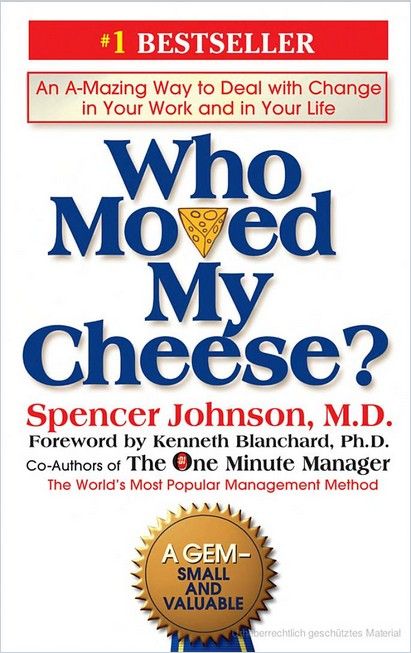You can’t evaluate this book’s contents without considering its almost immeasurable social impact.

Change!
You can’t evaluate the contents of this slender volume without also considering its almost immeasurable social impact: one million hardcover copies sold in 16 months; 21 million more copies went in the next five years. Pre-Cheese, Johnson was already a bestseller; he co-wrote the business classic The One-Minute Manager with Ken Blanchard. Johnson also wrote The New York Times bestseller The Present. Other self-help books in the Johnson universe include Out of the Maze and Peaks and Valleys.
Blanchard, among other friends, urged Johnson to write Cheese after hearing him recite its story. The tale, like all successful parables, is simple. Two “mice” and two mouse-sized “littlepeople” live in a maze. They find what appears to be a lifetime supply of cheese and settle down. But the cheese runs out, and the characters must face and cope with change. How they do it inspired millions of readers.
Johnson introduces the story by saying he underwent a personal crisis regarding change and how he responded to it, which generated profound self-insight. Rather than reveal the personal details of his crisis, Johnson created this teaching parable.
Parables
Parables – tales with a moral or teaching lesson, featuring symbolic or fanciful characters – have been around as long as people could speak. You can more easily recognize your strengths and flaws when they appear in the guise of a parable’s character. If a character in a story shares your name and exactly portrays your embarrassing, cowardly or self-sabotaging behavior, you might deny that the character resembles you at all.
Have you noticed that we don’t want to change when things change?Spencer Johnson
But when a cute mouse named “Sniff” or a littleperson named “Hem” acts the same way, you recognize yourself without feeling threatened. This makes you more receptive to the parable’s messages and thus more open to changing your behavior.
Charlie Jones
Blanchard’s rich introduction cites sportscaster Charlie Jones as an exemplar of Cheese behavior. Jones was an announcer for NBC for top events like Olympic track and field. He got an unpleasant surprise when his bosses assigned him to cover Olympic swimming and diving instead. Angry, Jones’s work suffered but reading Who Moved My Cheese? led him to change his attitude. Jones’s successful swim and dive competition announcing relaunched his career and eventually led to his induction into Broadcaster’s Alley in the Pro Football Hall of Fame.
Change
Blanchard explains that companies once prized loyalty, but today they prioritize flexibility. He says the only reliable status quo is change, but fear of change and the effects of this fear generate worker stress.
Prologue
The tale opens with an awkward – especially when compared with the momentum of the story – and not credible group of people who were friends in high school. After their high school reunion, they discuss, in a schematic way, their difficulties coping with change. One mentions reading Who Moved My Cheese? and the insight it provided into change and his response to it. The other diners clamor to hear the story. Johnson then launches into the allegory.
I used to be afraid of change. When a big change came along in our business, we didn’t know what to do. So we didn’t adjust, and we almost lost it.Spencer Johnson
This kind of prologue harks back to the ancient Greeks. In many classical stories, no one dives right into the narrative. The story usually begins with a set-up, like a similar gathering, and someone tells a story about a story. Today the prologue feels tiresome and precious. Readers can skip it.
Story
The tale is simpler, though Johnson hangs more decoration on it than it can usefully carry. Two mice, Sniff and Scurry, live in a maze along with Hem and Haw, two “littlepeople” – humans the size of mice. The four scamper around the maze seeking cheese. One day they discover a vast cache. In the days following, the mice race from their homes every morning to eat their cheese. Hem and Haw stroll over because they expect the cheese to be there every day. The mice assume the cheese will run out.
They had no idea where the Cheese came from or who had put It there. They just assumed it would be there.Spencer Johnson
And, Johnson reveals, one day it does run out. The mice instantly search for more. After some danger, they find another enormous supply. The littlepeople respond like human beings. Hem decries, “It’s not fair!” and after pointless soul-searching – “hemming and hawing” – Haw searches for new cheese. Hem remains behind, sulking. Johnson depicts him as refusing to face that he alone must find new cheese by his own efforts. Haw discovers a huge cache. He has insights into his journey of change and writes messages on the walls of the maze to encourage and guide his sulky comrade to follow him.
Johnson calls this “The Handwriting on the Wall.” Though most of these slogans might look best embroidered on potholders, they reinforce the fable’s message: “Change Happens,” “Anticipate Change,” “Monitor Change,” and so on – and the thought Johnson most wants you to retain: “Be Ready to Change Quickly and Enjoy It Again and Again.” The allegory ends with Haw enjoying his newfound cheese while searching the maze daily to stay informed on the overall cheese situation. One day, Haw hears a rustling, and wonders if Hem heeded the writing on the wall, showing that he, too, can change.
Discussion
Johnson closes with a wrap-up conversation among the same characters from the prologue. They discuss the fine points of the tale – unnecessarily. The pedagogic quality of the dialogue, especially after the charm and easy flow of the tale, renders this section difficult to read and unnecessary. The mice and the littlepeople already did the job.





